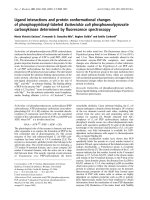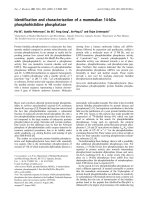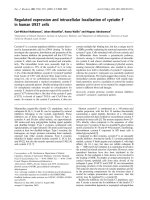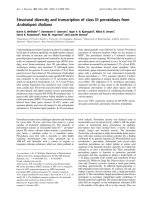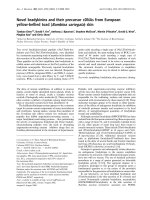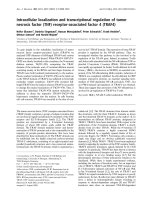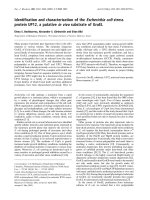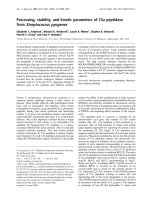Báo cáo y học: "PTPN22 polymorphism and anti-cyclic citrullinated peptide antibodies in combination strongly predicts future onset of rheumatoid arthritis and has a specificity of 100% for the disease" ppsx
Bạn đang xem bản rút gọn của tài liệu. Xem và tải ngay bản đầy đủ của tài liệu tại đây (120.86 KB, 6 trang )
Open Access
Available online />Page 1 of 6
(page number not for citation purposes)
Vol 8 No 1
Research article
PTPN22 polymorphism and anti-cyclic citrullinated peptide
antibodies in combination strongly predicts future onset of
rheumatoid arthritis and has a specificity of 100% for the disease
Martin Johansson
1
, Lisbeth Ärlestig
1
, Göran Hallmans
2
and Solbritt Rantapää-Dahlqvist
1
1
Department of Rheumatology, University Hospital, Umeå, Sweden
2
Department of Nutritional Research, University Hospital, Umeå, Sweden
Corresponding author: Solbritt Rantapää-Dahlqvist,
Received: 29 Sep 2005 Accepted: 21 Nov 2005 Published: 22 Dec 2005
Arthritis Research & Therapy 2006, 8:R19 (doi:10.1186/ar1868)
This article is online at: />© 2005 Johansson et al; licensee BioMed Central Ltd.
This is an open access article distributed under the terms of the Creative Commons Attribution License ( />),
which permits unrestricted use, distribution, and reproduction in any medium, provided the original work is properly cited.
Abstract
We analysed relationships between the PTPN22 1858
polymorphism and antibodies to cyclic citrullinated peptide
(CCP), rheumatoid factors (RFs) and the shared epitope (SE)
gene (HLA-DRB1*0404 or 0401) and determined their
combined predictive value for rheumatoid arthritis (RA) in
individuals who subsequently developed RA. This case-control
study was nested within the Medical Biobank of Northern
Sweden. Patients with RA (n = 92) were identified from
amongst blood donors antedating onset of disease by a median
of 2.4 (interquartile range 1.2 to 4.9) years. Matched controls
were selected randomly from the same cohorts (n = 368). Anti-
CCP antibodies and RFs were determined using enzyme-linked
immunoassays. Genotyping was performed using an ABI
PRISM 7900HT instrument and HLA-SE genes were identified
using PCR sequence-specific primers. The 1858T allele and
also carriage of T were associated with future onset of RA (odds
ratio (OR) = 2.29, 95% confidence interval (CI) 1.45–3.61 and
OR = 2.64, 95% CI 1.56–4.47, respectively). The combination
of the 1858T variant and anti-CCP antibodies gave 100%
specificity for the disease. None of the 368 controls expressed
this combination. The PTPN22 1858T variant and anti-CCP
antibodies were clearly associated (OR = 3.80, 95% CI 1.51–
9.57). A combination of the PTPN22 1858T variant and anti-
CCP antibodies gave a much higher relative risk (>132.03) for
developing RA than the combination of the T variant and HLA-
SE (OR = 7.85). The PTPN22 1858T variant was associated
with future development of RA. There was an association
between the T variant and anti-CCP antibodies and their
combination, found only among pre-patients, gives a very high
relative risk for development of RA. The combination gave a
specificity of 100% for diagnosing RA.
Introduction
A single nucleotide polymorphism in the PTPN22 gene encod-
ing the lymphoid protein tyrosine phosphatase (Lyp) has
recently been found to be associated with several autoimmune
disorders. The PTPN22 1858C/T polymorphism was origi-
nally associated with type I diabetes [1] and later with other
autoimmune diseases, for example, systemic lupus erythema-
tosus [2], Graves' disease [3] and Hashimoto thyroiditis [4].
Several studies report an association of it with rheumatoid
arthritis (RA) [4-10]; the association was primarily with sero-
positive disease [5,8] but two recent studies show association
with both sero-positive and sero-negative RA [9,10]. This
association with RA appears to be the most robust and repro-
ducible genetic association outside the human leukocyte anti-
gen (HLA) region. In several of the autoimmune diseases
associated with the PTPN22 polymorphism, the appearance
of autoantibodies precedes the development of overt clinical
disease by months or years [11-13]
We previously reported that antibodies against cyclic citrulli-
nated peptide (CCP) and IgA-rheumatoid factor (RF) predict
development of RA by a median of 2.5 years [14]. The pres-
ence of anti-CCP antibodies together with HLA shared
epitope (HLA-SE) genes (HLA-DRB1*0404/0401) increased
the relative risk for development of RA [15].
CCP = cyclic citrullinated peptide; CI = confidence interval; HLA-SE = human leukocyte antigen shared epitope; Lyp = lymphoid protein tyrosine
phosphatase; NSHDS = Northern Sweden Health and Disease Study; OR = odds ratio; RA = rheumatoid arthritis; RF = rheumatoid factor.
Arthritis Research & Therapy Vol 8 No 1 Johansson et al.
Page 2 of 6
(page number not for citation purposes)
In this study, we analysed the PTPN22 1858C/T polymor-
phism in relation to anti-CCP antibodies, RFs (IgM, IgG and
IgA) and HLA-SE gene carriage in individuals who had
donated blood before development of RA. The predictive
effects of the genes and antibodies were then evaluated.
Materials and methods
A nested case-control study was performed within the Medical
Biobank of Northern Sweden of the Northern Sweden Health
and Disease Study (NSHDS). All adults in Västerbotten
county were invited to participate; consequently, the cohort is
population-based and no individual was excluded. The Medi-
cal Biobank, conditions for recruitment into the cohorts, and
the collection and storage of blood samples have previously
been described in detail [14]. To identify whether our patients
diagnosed with RA (according to the American College of
Rheumatology 1987 criteria [16]) at the early arthritis clinic
within the Department of Rheumatology, University Hospital,
Umeå, had donated blood samples before any symptoms of
joint disease, the register of RA patients was co-analysed on
two occasions with those of the NSHDS Medical Biobank.
Ninety-two individuals (69 women and 23 men) were identi-
fied; in each case the date of onset of symptoms of joint dis-
ease was available. For every case (for instance, pre-patient),
four controls were randomly selected from within the NSHDS
registers and matched for sex, age at the time of blood sam-
pling and rural or urban residence. A total of 368 controls (276
women and 92 men) were selected. The mean age of the pre-
patients and of the controls at the time of blood sampling was
the same, namely 53 years (range 30 to 69 years). The median
sampling time before onset of symptoms of joint disease was
2.4 years (interquartile range 1.2 to 4.9 years). On average,
the diagnosis of RA was established 7.8 months (interquartile
range 5 to 10 months) after the first symptoms of joint disease.
The mean age at the onset of disease was 56.0 years (range
37 to 68 years). At the time of the study, the median disease
duration since diagnosis was 3.0 years (interquartile range
1.9–5.5 years). The Ethics Committee at the University Hospi-
tal, Umeå, approved this study and all participants gave their
written informed consent.
HLA-DRB1 genotyping was performed using PCR sequence-
specific primers from the DR low-resolution and DRB1*04
subtyping kits (Olerup SSP AB, Saltsjöbaden, Sweden)
according to the previously described method [15]. The HLA-
SE genes were defined as DRB1*0404 and DRB1*0401.
Two controls were randomly selected for each pre-patient.
The HLA-DRB1 typing was successful for 90 pre-patients and
173 controls. Anti-CCP antibodies (n = 89 for pre-patients
and n = 353 for controls) and the RFs of IgM, IgG and IgA iso-
types (in the first 59 pre-patients identified and 236 controls)
were determined using enzyme-linked immunoassays as previ-
ously described [14].
DNA was extracted from EDTA-treated whole blood using a
standard method. The PTPN22 1858C/T polymorphisms (sin-
gle nucleotide polymorphism number is rs2476601) were
determined with the 5' nuclease assay. DNA was unavailable
for PTPN22 genotyping for three patients and two controls.
Primers and probes were designed by Applied Biosystems
(Foster City, CA, USA). The forward primer was 5'-CAACT-
GCTCCAAGGATAGATGATGA-3'and the reverse primer
was5'-CCAGCTTCCTCAACCACAATAAATG-3'. The probes
were labelled at their 5' ends with FAM™ (the C allele) and
VIC™ (the T allele) and the 3' ends contained quenchers and
minor groove binders. The probe for the A allele was 5'-6FAM-
TCAGGTGTCCGTACAGG-MGB-Q-3' and for the G allele
5'-VIC-TCAGGTGTCCATACAGG-MGB-Q-3'. Primers and
probes were mixed with TaqMan
®
Universal PCR Master Mix,
No AmpErase
®
UNG (Applied Biosystems, Foster City, CA,
USA) and added to 96-well microtitre plates, each well of
which contained 10 ng of air-dried DNA. The PCR-reactions
were performed according to the manufacturer's instructions
and detection of the different genotypes made using an ABI
Table 1
Frequency distribution of the PTPN22 1858C/T polymorphism
Pre-patients (n = 89) Controls (n = 360) χ
2
P value OR 95% CI
N%n%
CC 54 60.7 289 80.3 15.21 0.00010 0.38 0.22–0.64
CT 33 37.1 68 18.9 13.54 0.00025 2.52 1.48–4.30
TT
a
2 2.2 3 0.8 1.30 0.2586 2.74 0.31–20.46
CT + TT 35 39.3 71 19.7 15.21 0.00010 2.64 1.56–4.47
T allele 37 20.8 74 10.3 14.55 0.00013 2.29 1.45–3.61
Frequencies of PTPN22 1858C/T genotypes and of the T allele were determined in individuals who later developed rheumatoid arthritis (pre-
patients) and in controls.
a
Fisher's exact test (two-sided). CI, confidence interval; OR, odds ratio.
Available online />Page 3 of 6
(page number not for citation purposes)
PRISM
®
7900HT Sequence Detector System (Applied Bio-
systems). Data were processed using SDS 2.1 software
(Applied Biosystems). The different genotypes were verified
by comparison with controls of known genotype. Genotyping
was unsuccessful for six controls.
The Chi-square test was used for testing categorical data
between groups. To assess the utility of the various antibodies
and genes in detecting prospective RA patients, sensitivity,
specificity and likelihood values were calculated. Conditional
logistic regression models were used to estimate the predic-
tive values of the antibodies analysed, the PTPN22 1858T var-
iant, the RFs, and HLA-SE gene carriage for RA. Odds ratios
(ORs) were calculated with 95% confidence intervals (CIs).
All p-values refer to a two-sided test and a p value ≤0.05 was
considered statistically significant. The calculations were per-
formed using the SPSS package (SPSS for Windows 12.0:
SPSS Inc., Chicago, IL, USA). Power calculations based on
the frequency among our controls and among RA patients
from other studies showed that four controls per patient would
be sufficient.
Results
The genotype and allele distribution of the PTPN22 1858C/T
single nucleotide polymorphism were in agreement with the
Hardy-Weinberg equilibrium among both the pre-patient
group and the control population. The genotype frequencies
differed significantly between the pre-patients and the controls
(χ
2
= 15.37, 2 degrees of freedom, p = 0.0005) (Table 1).
Carriage of the PTPN22 1858T variant (CT+TT) was signifi-
cantly increased in pre-patients compared with controls, as
was the frequency of the T allele (OR = 2.64, 95% CI 1.56–
4.47 and OR = 2.29, 95% CI 1.45–3.61, respectively) (Table
1). The CC genotype was significantly decreased (OR = 0.38,
95% CI 0.22–0.64). Carriage of T was associated with the
development of RA (χ
2
= 15.21, P = 0.0001) as was carriage
of the HLA-SE gene (χ
2
= 7.28, P = 0.007).
The sensitivity of PTPN22 1858T carriage for identifying pre-
patients was lower compared with HLA-SE but of the same
magnitude as presence of anti-CCP antibodies (Table 2). The
specificity, however, was greater with PTPN22 1858T car-
riage than with HLA-SE but less than with anti-CCP antibod-
ies. The combination of anti-CCP antibodies and PTPN22 T
carriage gave a specificity of 100%. The highest likelihood
ratio was for anti-CCP antibodies (26.2), followed by the dif-
ferent RFs (3.7 to 8.3). The PTPN22 1858T variant had a
higher likelihood ratio than HLA-SE (2.0 and 1.5, respectively).
The combination of carrying both gene variants, however, gave
a higher likelihood ratio (3.4).
Carriage of the PTPN22 1858T variant and presence of anti-
CCP antibodies were significantly associated in the pre-
patients (χ
2
= 8.39, P = 0.004, OR = 3.80, 95% CI 1.51–
9.57). None of the controls carrying the T variant had anti-CCP
antibodies. Nor was there any significant relationship between
carriage of the PTPN22 1858T variant and any of the RF iso-
types or HLA-SE, either in pre-patients or in controls (data not
presented). There was no significant relationship between
HLA-SE and anti-CCP antibodies in either of the groups (data
not presented). In multiple conditional logistic regression anal-
ysis with carriage of the PTPN22 1858T variant and HLA-SE
as independent variables, both predicted RA but with the
PTPN22 1858T variant giving the highest value (OR = 3.51,
95% CI 1.85–6.68 and OR = 2.19, 95% CI 1.22–3.94,
respectively).
To analyse the relative risk of developing RA, carriage of the
PTPN22 1858T variant was combined with anti-CCP antibod-
Table 2
Sensitivity, specificity, 95% confidence intervals and likelihood ratios
Sensitivity Specificity Likelihood ratio
% 95% CI % 95% CI
PTPN22 CT+TT 39.3 29.6–49.7 80.3 75.9–84.1 2.0
Anti-CCP Abs 37.1 27.5–47.5 98.6 96.9–99.5 26.2
IgG-RF 16.9 8.9–28.1 95.8 92.6–97.8 4.0
IgA-RF 42.4 30.3–55.2 94.9 91.5–97.2 8.3
IgM-RF 22.0 12.8–33.9 94.1 90.5–96.6 3.7
SE (B1*0404 or 0401) 55.6 45.2–65.6 61.8 54.4–68.9 1.5
SE + PTPN22 CT+TT 24.1 16.0–34.0 92.9 88.3–96.1 3.4
Anti-CCP Abs + PTPN22 CT+TT 22.1 14.3–31.8 100.0 - -
Sensitivity, specificity, 95% confidence intervals (CIs) and likelihood ratios were determined for the presence of the PTPN22 1858T variant
(CT+TT), anti-cyclic citrullinated peptide antibodies (anti-CCP Abs), rheumatoid factors IgM-RF, IgG-RF and IgA-RF, and carriage of human
leukocyte antigen shared epitope (HLA-SE) in pre-patients and matched controls.
Arthritis Research & Therapy Vol 8 No 1 Johansson et al.
Page 4 of 6
(page number not for citation purposes)
Table 3
Conditional logistic regression analyses of combinations of genes and antibodies
Combination of variables Pre-patients Controls OR 95% CI
n%n%
PTPN22 CT+TT
-
+ anti-CCP Abs
-
39 45.3 272 78.4 1.00
PTPN22 CT+TT
+
+ anti-CCP Abs
-
15 17.5 70 20.2 1.20 0.62–2.35
PTPN22 CT+TT
-
+ anti-CCP Abs
+
13 15.1 5 1.4 16.61 4.68–58.97
PTPN22 CT+TT
+
+ anti-CCP Abs
+
19 22.1 0
a
0.0 132.03
a
17.84–2720.91
a
PTPN22 CT+TT
-
+ IgG-RF
-
27 48.2 175 76.1 1.00
PTPN22 CT+TT
+
+ IgG-RF
-
19 33.9 46 20.0 2.47 1.26–4.85
PTPN22 CT+TT
-
+ IgG-RF
+
9 16.1 6 2.6 10.08 3.00–33.94
PTPN22 CT+TT
+
+ IgG-RF
+
1 1.8 3 1.3 1.50 0.15–14.84
PTPN22 CT+TT
-
+ IgA-RF
-
23 41.1 171 74.3 1.00
PTPN22 CT+TT
+
+ IgA-RF
-
11 19.6 47 20.4 1.55 0.69–3.49
PTPN22 CT+TT
-
+ IgA-RF
+
13 23.2 10 4.4 9.23 3.31–25.76
PTPN22 CT+TT
+
+ IgA-RF
+
9 16.1 2 0.9 21.42 4.45–103.16
PTPN22 CT+TT
-
+ IgM-RF
-
28 50.0 170 73.9 1.00
PTPN22 CT+TT
+
+ IgM-RF
-
16 28.6 46 20.0 1.97 0.98–4.04
PTPN22 CT+TT
-
+ IgM-RF
+
8 14.3 11 4.8 4.65 1.65–13.13
PTPN22 CT+TT
+
+ IgM-RF
+
4 7.1 3 1.3 10.70 1.78–64.23
PTPN22 CT+TT
-
+ SE
-
24 27.6 86 50.6 1.00
PTPN22 CT+TT
+
+ SE
-
14 16.1 18 10.6 3.35 1.34–8.26
PTPN22 CT+TT
-
+ SE
+
28 32.2 54 31.8 2.12 1.06–4.25
PTPN22 CT+TT
+
+ SE
+
21 24.1 12 7.0 7.85 3.03–20.30
Results of conditional logistic regression analyses of carriage of the PTPN22 1858T variant (CT + TT), HLA shared epitope (SE), anti-cyclic
citrullinated peptide antibodies (anti-CCP Abs) or rheumatoid factors (RFs) of IgG, IgM, or IgA isotype for the prediction of rheumatoid arthritis in
individuals who later developed the disease and matched controls.
a
Calculations made with a hypothetical control individual positive for both the
PTPN22 1858T variant and anti-CCP antibodies.
ies, RFs (IgG-RF, IgA-RF and IgM-RF) and with HLA-SE in
conditional logistic regression analyses. The combination of
anti-CCP antibodies and carriage of the PTPN22 1858T vari-
ant gave a very high OR compared with not having any of
them. As none of the controls had this combination, the OR
was calculated assuming one individual did, resulting in a
value of 132.03, although the relative risk was actually infinite
(Table 3). Carriage of the T variant combined with RFs gave
the highest OR for IgA-RF (OR = 21.42) followed by IgM-RF
(OR = 10.70) compared with individuals not having any of
them. The combination of the T variant with IgG-RF did not
give a significant relative risk. The combination of the PTPN22
1858T variant with HLA-SE gave an OR of 7.85, which was
greater than that for either of them separately (OR = 3.35 and
OR = 2.12, respectively), all compared with not having either
of them.
Discussion
This study involved individuals who had donated blood sam-
ples to the Medical Biobank of the NSHDS prior to developing
any RA symptoms. In these pre-patients who developed RA,
there was an association of it with the PTPN22 1858C/T pol-
ymorphism, consistent with previous reports on RA [4-10].
We also found that the presence of anti-CCP antibodies was
significantly associated with carriage of the T variant and there
was a greatly increased relative risk for the development of RA
Available online />Page 5 of 6
(page number not for citation purposes)
in individuals with a combination of the PTPN22 1858T variant
and anti-CCP antibodies. This relative risk was much higher
than with the combination of HLA-SE and anti-CCP antibod-
ies, as we have previously reported [15]. In our previous study,
the OR was 66.8 whereas that for the combination of the
PTPN22 1858T variant and anti-CCP antibodies was
>132.03 based on a calculation using one hypothetical con-
trol subject as being positive for both PTPN22 1858T and
anti-CCP antibodies. None of the control subjects with the
PTPN22 1858T variant were seropositive for anti-CCP anti-
bodies. Anti-CCP antibodies were only present in controls
with the 1858CC genotype (n = 5). This could suggest that
the PTPN22 T variant influences the progression of overt
autoimmune disease once autoantibodies, such as anti-CCP
antibodies, have developed. This is the first study to show an
association between the PTPN22 1858T variant and a dis-
ease related autoantibody, and that they co-operate to
increase the relative risk of developing an autoimmune dis-
ease, in this case RA.
Our data suggest that carriage of the PTPN22 1858T variant
is of greater importance than HLA-SE for the development of
RA. There was an increased relative risk of developing RA with
the combination of the PTPN22 T variant and HLA-SE; how-
ever, this relative risk was lower than with the combinations of
the T variant with IgA-RF or IgM-RF. With respect to RFs, we
have reported higher relative risks for developing RA with the
combination of HLA-SE and RFs in a smaller cohort of the
same study population [15]. We did not find the significant
association with carriage of the T variant and RFs suggested
by some studies [5,8] but our results are in concordance with
others [9,10].
The function of Lyp, the protein the PTPN22 gene encodes, is
suggested to be negative regulation of T-cell signalling, as
demonstrated in an animal model [17] and in human cell lines
[5]. The functional effect of the PTPN22 1858 polymorphism
on T-cells in humans is yet to be demonstrated. The Lyp pro-
tein is expressed in other cell types: B-cells, monocytes, neu-
trophils, dendritic cells and natural killer cells [5]. In a mouse
knockout model lacking the murine homologue of human
PTPN22 (PEST domain-enriched tyrosine phosphatase
(PEP)), the threshold for T-cell receptor signalling was low-
ered and the number of effector and memory T-cells increased
[17]. The knockout mice also showed an increased number of
germinal centres and increased immunoglobulin levels,
although autoantibodies were not detected in these animals.
Changes in B-cell function were not found, suggesting that the
abnormalities reflect a role of T-cell regulation on B-cell differ-
entiation. PTPN22 1858T changes codon 620 from arginine
into tryptophan. This amino acid change disrupts the binding
of Lyp to an intracellular kinase, Csk, which can then no longer
inactivate another kinase, Lck, that is involved in T-cell signal-
ling. The result of this missense mutation is a possible loss of
negative regulation of T-cell signalling [1,5].
A limitation of this study is the relatively small number of pre-
patients identified who later developed RA, which was further
reduced in terms of analysis of RFs, and of controls genotyped
for HLA-SE. The study cohort (NSHDS) is population-based
and no exclusion criteria were applied. The controls could
have included two to four individuals with RA (calculated using
a prevalence for RA of 0.5% to 1.0%), which could explain the
number of individuals among the controls positive for anti-
CCP antibodies.
Conclusion
This study shows a strong association between the PTPN22
1858T variant and future development of RA. This association
is stronger than that for HLA-SE and is the better predictor for
RA. We also show an association between the T variant and
anti-CCP antibodies but not RFs. The combination of the
PTPN22 1858T variant and anti-CCP antibodies was found
only among pre-patients, making it a strong predictor for the
development of RA, possibly by influencing the progression of
an overt autoimmune disease.
Competing interests
The authors declare that they have no competing interests.
Authors' contributions
MJ was a main investigator and carried out the genotyping, the
statistics and contributed to preparation of the manuscript. LÄ
participated in the collection of the material and registration of
the pre-patient data. GH is responsible for the Medical
Biobank of NSHDS and delivered the DNA samples. SR-D is
the principal investigator, is responsible for the Biobank sam-
ples, designed the investigation, and participated in data col-
lection, statistical analysis and drafting of the manuscript.
Acknowledgements
This work was supported by grants from Swedish Research Council
(K2003-74XD-14705-01), King Gustaf V's 80-Year Fund, the Swedish
Rheumatism Association, and the Medical Faculty of Umeå University,
Umeå, Sweden. We thank Hans Stenlund, PhD, Department of Epide-
miology, for helpful discussion regarding statistical analyses and Ewa
Berglin, MD, Department of Rheumatology, for discussion regarding the
material. Erik Jidell, MD Department of Transfusion Medicine, Ulf Sundin,
PhD, Clinical Immunology, Karolinska University Hospital, Stockholm,
Sweden. Walther J van Venrooij, PhD, Department of Biochemistry, Uni-
versity of Nijmegen, Nijmegen, The Netherlands are thanked for their col-
laboration. Solveig Linghult and Thord Johansson are gratefully
acknowledged for technical assistance. The staff of the Medical
Biobank, and the Early Arthritis Clinic, Department of Rheumatology,
University Hospital of Umeå, are gratefully acknowledged.
References
1. Bottini N, Musumeci L, Alonso A, Rahmouni S, Nika K, Rostam-
khani M, MacMurray J, Meloni GF, Lucarelli P, Pellecchia M, et al.:
A functional variant of lymphoid tyrosine phosphatase is asso-
ciated with type I diabetes. Nat Genet 2004, 36:337-338.
2. Kyogoku C, Langefeld CD, Ortmann WA, Lee A, Selby S, Carlton
VE, Chang M, Ramos P, Baechler EC, Batliwalla FM, et al.:
Genetic association of the R620W polymorphism of protein
Arthritis Research & Therapy Vol 8 No 1 Johansson et al.
Page 6 of 6
(page number not for citation purposes)
tyrosine phosphatase PTPN22 with human SLE. Am J Hum
Genet 2004, 75:504-507.
3. Velaga MR, Wilson V, Jennings CE, Owen CJ, Herington S, Don-
aldson PT, Ball SG, James RA, Quinton R, Perros P, Pearce SH:
The codon 620 tryptophan allele of the lymphoid tyrosine
phosphatase (LYP) gene is a major determinant of Graves'
disease. J Clin Endocrinol Metab 2004, 89:5862-5865.
4. Criswell LA, Pfeiffer KA, Lum RF, Gonzales B, Novitzke J, Kern M,
Moser KL, Begovich AB, Carlton VE, Li W, et al.: Analysis of fam-
ilies in the Multiple Autoimmune Disease Genetics Consor-
tium (MADGC) collection: the PTPN22 620W allele associates
with multiple autoimmune phenotypes. Am J Hum Genet
2005, 76:561-571.
5. Begovich AB, Carlton VE, Honigberg LA, Schrodi SJ, Chokkalin-
gam AP, Alexander HC, Ardlie KG, Huang Q, Smith A, Spoerke JM,
et al.: A missense single-nucleotide polymorphism in a gene
encoding a protein tyrosine phosphatase (PTPN22) is associ-
ated with rheumatoid arthritis. Am J Hum Genet 2004,
75:330-337.
6. Orozco G, Sanchez E, Gonzalez-Gay MA, Lopez-Nevot MA, Torres
B, Caliz R, Ortego-Centeno N, Jiménez-Alonso J, Pascual-Salcedo
D, Balsa A: Association of a functional single-nucleotide poly-
morphism of PTPN22, encoding lymphoid protein phos-
phatase, with rheumatoid arthritis and systemic lupus
erythematosus. Arthritis Rheum 2005, 52:219-224.
7. Hinks A, Barton A, John S, Bruce I, Hawkins C, Griffiths CE, Donn
R, Thomson W, Silman A, Worthington J: Association between
the PTPN22 gene and rheumatoid arthritis and juvenile idio-
pathic arthritis in a UK population. Arthritis Rheum 2005,
52:1694-1699.
8. Lee AT, Li W, Bombardier C, Weisman M, Massarotti EM, Kent J,
Wolfe F, Begovich AB, Gregersen PK: The PTPN22 R620W pol-
ymorphism associates with RF positive rheumatoid arthritis in
a dose-dependent manner but not with HLA-SE status. Genes
Immun 2005, 6:129-133.
9. van Oene M, Wintle RF, Liu X, Yazdanpanah M, Gu X, Newman B,
Kwan A, Johnson B, Owen J, Greer W, et al.: Association of the
lymphoid tyrosine phosphatase R620W variant with rheuma-
toid arthritis, but not with Crohn's disease, in Canadian popu-
lations. Arthritis Rheum 2005, 52:1993-1998.
10. Simkins HM, Merriman ME, Highton J, Chapman PT, O'Donnell JL,
Jones PB, Gow PJ, McLean L, Pokorny V, Harrison AA: Associa-
tion of the PTPN22 locus with rheumatoid arthritis in a New
Zealand Caucasian cohort. Arthritis Rheum 2005,
52:2222-2225.
11. Strieder TG, Prummel MF, Tijssen JG, Endert E, Wiersinga WM:
Risk factors for and prevalence of thyroid disorders in a cross-
sectional study among healthy female relatives of patients
with autoimmune thyroid disease. Clin Endocrinol (Oxf) 2003,
59:396-401.
12. Arbuckle MR, McClain MT, Rubertone MV, Scofield RH, Dennis
GJ, James JA, Harley JB: Development of autoantibodies before
the clinical onset of systemic lupus erythematosus. N Engl J
Med 2003, 349:1526-1533.
13. Hoppu S, Ronkainen MS, Kulmala P, Akerblom HK, Knip M:
GAD65 antibody isotypes and epitope recognition during the
prediabetic process in siblings of children with type I diabetes.
Clin Exp Immunol 2004, 136:120-128.
14. Rantapaa-Dahlqvist S, de Jong BA, Berglin E, Hallmans G, Wadell
G, Stenlund H, Sundin U, van Venrooij WJ: Antibodies against
cyclic citrullinated peptide (CCP) and immunoglobulin-A rheu-
matoid factor predict the development of rheumatoid arthritis.
Arthritis Rheum 2003, 48:2741-2749.
15. Berglin E, Padyukov L, Sundin U, Hallmans G, Stenlund H, van
Venrooij WJ, Klareskog L, Dahlqvist SR: A combination of
autoantibodies to cyclic citrullinated peptide (CCP) and HLA-
DRB1 locus antigens is strongly associated with future onset
of rheumatoid arthritis. Arthritis Res Ther 2004, 6:R303-308.
16. Arnett FC, Edworthy SM, Bloch DA, McShane DJ, Fries JF, Cooper
NS, Healey LA, Kaplan SR, Liang MH, Luthra HS, et al.: The Amer-
ican Rheumatism Association 1987 revised criteria for the
classification of rheumatoid arthritis. Arthritis Rheum 1988,
31:315-324.
17. Hasegawa K, Martin F, Huang G, Tumas D, Diehl L, Chan AC:
PEST domain-enriched tyrosine phosphatase (PEP) regula-
tion of effector/memory T cells. Science 2004, 303:685-689.
